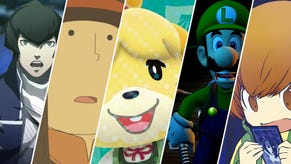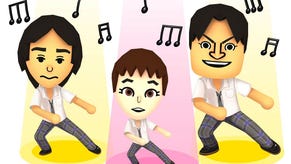Tomodachi Life 3DS Review: Conversation Piece
Your appreciation for Nintendo's weird new life sim hinges entirely on how much amusement you derive from caricatures of your friends spouting bizarre nonsense.
This article first appeared on USgamer, a partner publication of VG247. Some content, such as this article, has been migrated to VG247 for posterity after USgamer's closure - but it has not been edited or further vetted by the VG247 team.
I never really played much of The Sims. I heard a lot about it, though — the girl I was dating back around the time it launched really got into it.
Not surprisingly, her main Sims were tiny renditions of the two of us, setting up house together and basically being, well, us. There was no "Hey, wouldn't this be great, hint hint, maybe think about buying me a ring" message behind this; she was simply dabbling in the natural intersection of the human fascination with playing God and our intrinsic existential vanity. Over the course of several weeks, she filled me in with periodic updates about our fake lives together: How we got along, when we argued, the idiomatic quirks or our respective simulacra. It was a fascinating exercise in voyeurism: Peeping on ourselves.
Eventually, she started dabbling in fan add-ons. She downloaded a tiny Galaga arcade machine for me to play on, for example, as well as other things not in the game's legitimate sandbox. At one point she found a hamster add-on module. It soon turned out that hamsters could carry a disease that could spread to Sims, with potentially lethal results, and before long our domestic bliss ended in side-by-side graves. Not a great omen for the relationship, as it would later turn out.

You never need to worry about something like this happening Tomodachi Life, Nintendo's new Sims-alike game. That's because, as you'd expect for a Nintendo game, it's a completely closed system, with no modding potential allowed. Tomodachi Life takes a much more limited and stripped-down take on the life simulation concept than other similar games, including the company's own Animal Crossing. And, as is often the case with Nintendo's our-way-or-the-highway approach to game experiences, this highly streamlined approach has both good and bad points.
As such, it'll be a tough sell for many core gamers. Tomodachi Life somehow manages to be even less goal-oriented than most sandbox simulations; at least modern Sims games give you huge neighborhoods and generational life cycles, and Animal Crossing at least has that ever-growing mortgage to worry about. Tomodachi Life lets your characters get married (provided they're not aiming for a same-sex union, of course) and have kids, but after a week of constant play that's as far as I've seen it go. There's customization aplenty, but strictly in the sense that you're reskinning your apartment or wardrobe with limited, predefined objects.
Really, Tomodachi Life doesn't offer much to do beyond listen to your little sim citizens ask for favors and participate in events around town. Everyone lives in the same apartment complex (moving out to a house after getting hitched) and will occasionally request favors ranging from food to dating advice. There are some simple minigames to play, which pop up somewhat at random, though there aren't as many of these to pick from as you might hope. And at any given time, there's only enough happening to keep you occupied for 15 or 20 minutes per session.

As a video game in the classic sense of the word, Tomodachi Life is basically a bust. Which is probably the point; at heart, this simply amounts to Nintendo's latest attempt to win over general audiences with a decidedly non-video-gamey video game. Tomodachi Life is about social engineering opportunities — and, of course, facilitating naked voyeurism. But, you know, these are much more universally appealing concepts than shooting aliens in the face to wallow in a spray of blood-particle physics. Tomodachi speaks to a completely different sickness of the human condition than violent games to. God mode is the de facto Tomodachi Life experience, not just an Easter egg.
Tomodachi Life's entire selling point comes from the almost alarming accuracy with which it allows you to simulate the people you know. Not that you're limited to creating folks you know in real life; for all the game cares, you can fill the apartment complex with the cast of Lost, the current political regime, Jesus and his Apostles, or a bunch of formless nobodies. However, the game gains far more potency when you use it to tinker in the lives of people you know; its personality-definition system works on a series of sliders for unconventional traits like quirkiness versus normalcy, speediness versus deliberation, and more.

These offbeat categories translate shockingly well into functional personalities, defining your little people on a grid that's somewhere between a Meyers-Briggs test and a Punnett square. The Miis of Tomodachi Life make idle remarks based on where they fall in the personality grid, and they're startlingly on-point. Where it really gets creepy is when you start customizing your creations' voices, tweaking the pitch, tone, and speed with which they talk. While the resulting speech carries the sharp edge of speech synthesis, it's damn good speech synthesis, making for extremely varied talking patterns for your Tomodachi dwellers. It correctly pronounces standard English and does a pretty good job of hitting uncommon words or proper nouns by allowing you to define them phonetically. Throw in custom catchphrases and physical tics and you have a game that becomes absolutely fascinating in its ability to emulate the essence of the familiar.
My litmus test for Tomodachi Life has, once again, been my significant other — in this case my wife, a non-gamer if ever there was one. But she's insisted on sitting close at hand as I work through my review of Tomodachi Life to help shape people we know and watch how they interact. She's constantly exclaiming, "How did it know she says that!? Did you tell the game?" No, I explain; the game's just really good at matching dialogue to personalities. Or maybe everyone we know is just depressingly predictable in their behavior. The net result works out all the same: She finds Tomodachi Life fascinating, as do all the people with whom she's shared video clips and screenshots.
For my part, I'm certainly not immune to its charms, either. While experienced gamers can pretty easily dismantle the systems and processes that make Tomodachi Life work, I'm much happier to simply play along with the illusion. The fact that we're even playing the game in English at all stands as a towering feat of localization; the game was designed for the Japanese market, with speech synthesis built around the predictable phonemes and rhythms of Japanese, and there was supposedly no intention to ever bring it west. But Nintendo managed to make the game's chattiness work in English, which in turn allowed the Treehouse's internal localization teams to bring the full quirkiness of their writing habits to bear on the game. Tomodachi is every bit as weird and charming as Animal Crossing, but instead of speaking in high-speed jibber-jabber, its characters communicate in cogent language. It makes a massive difference.

Actually, Tomodachi Life is weirder than Animal Crossing. It's a product of Nintendo's SPD Group 1, which is comprised in part of the former R&D1 division — the group responsible for Nintendo's most bizarre creations. While Tomodachi Life puts a more normal face on things with its mundane Miis, you can still see the anarchic spirit of R&D1 lurking beneath the surface. The same commitment to gleeful weirdness that brought the Game Boy Camera, WarioWare, and Rhythm Heaven to life lurks behind the scenes in Tomodachi Life, peeking out most frequently in the bits where you peep into your Miis' dreams. Other life simulators, such as Animal Crossing and The Sims, try to be funny or zany and often only manage "cringe-inducing." Tomodachi Life, on the other hand, manages to be legitimately bizarre.
And that's basically the appeal of the game in a nutshell: The ability to create stunningly faithful cartoon renditions of everyone you know and love, then set them free to be weird. To let them have odd conversations and pursue impossible romantic relationships. There's a certain therapeutic value to the game as well — a chance to woo your secret crush, or torment the avatar of someone you hate. Like so many of Nintendo's casual titles, it's the kind of game you don't play in marathon sessions but rather return to regularly for little sessions to lord over a tiny world and watch it spin into hilarious chaos. And it's the kind of game that makes you want to return for those little sessions for a long, long time to come.
VisualsAs in Nintendo's other casual games, e.g. the Wii (Whatever) series, they simply get the job done. In this case, the mishmash of bobble-headed 3D models and stock-footage photo objects helps sell the game's surreality.
SoundThe music tends to be irritating, but you'll keep the sound cranked anyway to enjoy the surprisingly excellent (and customizable!) speech synthesis.
InterfaceIn keeping with the overall theme, it's limited — or rather, lean, and low on distractions.
Lasting AppealAs with most life sims, it's a love it or hate it affair. If you love it, you'll play for ages despite a tendency toward repetition.
ConclusionThe latest of Nintendo's experiments to create games with appeal beyond the usual clichés of the medium, Tomodachi Life may actually be the most humanistic creation the company has ever put together. While it could (somewhat notoriously) stand to be more inclusive, its focus on the concrete personalities and tangible interactions of tiny digital people make it one of the most addictive and fascinating life sims ever made.















